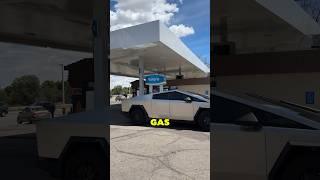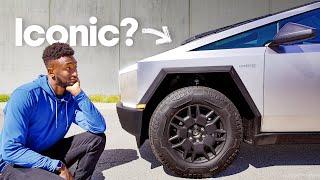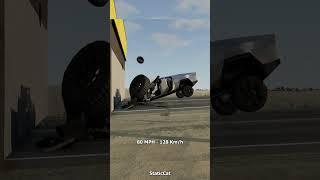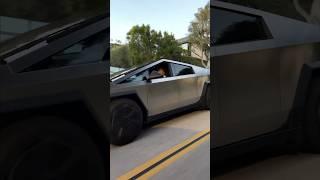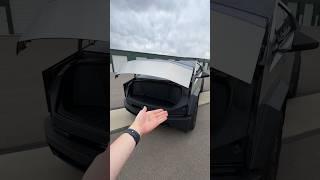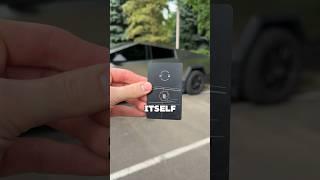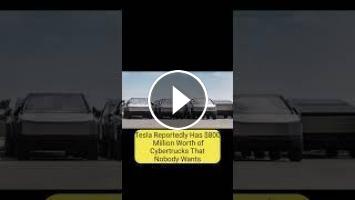Tesla, once hailed as a trailblazer in the electric vehicle (EV) industry, is currently facing significant challenges with the Cybertruck—its highly anticipated, futuristic pickup truck. Despite substantial pre-launch hype and a strong brand legacy, recent reports indicate that Tesla is now grappling with a large inventory of unsold Cybertrucks. Industry analysts estimate that over 10,000 Cybertrucks remain unpurchased, representing more than $800 million in unsold inventory. This development raises important questions about the Cybertruck’s market appeal, production strategy, pricing structure, and overall product quality.
Initially introduced in 2019, the Tesla Cybertruck generated massive attention due to its unconventional, angular design and bold performance claims. At launch, CEO Elon Musk promised a base model starting at $39,900, boasting a range of up to 500 miles, along with revolutionary features such as bulletproof exoskeleton panels and a range extender to boost long-distance travel. However, many of these promises have either been significantly scaled back or failed to materialize entirely. For instance, the entry-level Cybertruck now starts at approximately $60,990, while the premium “Cyberbeast” variant exceeds $96,000. The optional $16,000 range extender, which was intended to alleviate range anxiety, has reportedly been discontinued—causing disappointment among early reservation holders.
Quality concerns have also played a role in dampening enthusiasm for the Cybertruck. Tesla has issued multiple recalls, citing issues with the accelerator pedal, inverter systems, and the alignment and integrity of the stainless steel body panels. Safety critics have raised concerns regarding the Cybertruck’s design, particularly its pedestrian impact risks due to the sharp-edged exterior. These safety issues have led to the vehicle being banned or restricted in some international markets, including the United Kingdom.
In terms of manufacturing, Tesla has encountered difficulties producing the Cybertruck at scale. The use of ultra-hard 30X cold-rolled stainless steel, while visually striking and durable, has posed unique engineering challenges that have slowed production and limited supply. Despite setting a production goal of 250,000 Cybertrucks annually, Tesla’s output has fallen short. This has affected Tesla's ability to deliver on backorders and capitalize on early interest.
Meanwhile, the electric pickup truck segment has become increasingly competitive. Rivian’s R1T, Ford’s F-150 Lightning, and other more affordable or practical EV trucks have gained traction, drawing consumer attention away from Tesla. Notably, startups like Slate Auto are offering simplified and minimalist EV trucks at a base price of $25,000—with over 100,000 preorders reported. These alternatives appeal to buyers prioritizing functionality, affordability, and reliability over experimental design.
Additionally, Tesla’s brand image has been impacted by the public behavior and polarizing statements of CEO Elon Musk. Former Tesla employees and some industry observers have expressed concerns that Musk’s political and personal controversies have begun to erode consumer trust, particularly among mainstream and environmentally conscious demographics. Combined with declining resale value and softening demand, these concerns have contributed to a broader perception that Tesla may be losing its competitive edge in the evolving EV market.
To stimulate demand, Tesla has recently implemented price reductions on some Cybertruck models, with discounts up to $6,000. Despite this, inventory levels remain high, and resale prices on secondary markets have dropped below original purchase costs—a stark contrast to earlier Tesla models that appreciated in value shortly after release.
In conclusion, Tesla’s struggle with unsold Cybertruck inventory represents a convergence of missed expectations, quality control challenges, shifting market dynamics, and intensified competition. While the Cybertruck was envisioned as a bold leap forward in automotive innovation, its current reception highlights the risks of overpromising, underdelivering, and failing to align product design with market demand. For Tesla to regain momentum in the EV truck space, it will need to prioritize transparency, quality assurance, and competitive pricing, while addressing evolving consumer preferences with humility and strategic foresight.
Initially introduced in 2019, the Tesla Cybertruck generated massive attention due to its unconventional, angular design and bold performance claims. At launch, CEO Elon Musk promised a base model starting at $39,900, boasting a range of up to 500 miles, along with revolutionary features such as bulletproof exoskeleton panels and a range extender to boost long-distance travel. However, many of these promises have either been significantly scaled back or failed to materialize entirely. For instance, the entry-level Cybertruck now starts at approximately $60,990, while the premium “Cyberbeast” variant exceeds $96,000. The optional $16,000 range extender, which was intended to alleviate range anxiety, has reportedly been discontinued—causing disappointment among early reservation holders.
Quality concerns have also played a role in dampening enthusiasm for the Cybertruck. Tesla has issued multiple recalls, citing issues with the accelerator pedal, inverter systems, and the alignment and integrity of the stainless steel body panels. Safety critics have raised concerns regarding the Cybertruck’s design, particularly its pedestrian impact risks due to the sharp-edged exterior. These safety issues have led to the vehicle being banned or restricted in some international markets, including the United Kingdom.
In terms of manufacturing, Tesla has encountered difficulties producing the Cybertruck at scale. The use of ultra-hard 30X cold-rolled stainless steel, while visually striking and durable, has posed unique engineering challenges that have slowed production and limited supply. Despite setting a production goal of 250,000 Cybertrucks annually, Tesla’s output has fallen short. This has affected Tesla's ability to deliver on backorders and capitalize on early interest.
Meanwhile, the electric pickup truck segment has become increasingly competitive. Rivian’s R1T, Ford’s F-150 Lightning, and other more affordable or practical EV trucks have gained traction, drawing consumer attention away from Tesla. Notably, startups like Slate Auto are offering simplified and minimalist EV trucks at a base price of $25,000—with over 100,000 preorders reported. These alternatives appeal to buyers prioritizing functionality, affordability, and reliability over experimental design.
Additionally, Tesla’s brand image has been impacted by the public behavior and polarizing statements of CEO Elon Musk. Former Tesla employees and some industry observers have expressed concerns that Musk’s political and personal controversies have begun to erode consumer trust, particularly among mainstream and environmentally conscious demographics. Combined with declining resale value and softening demand, these concerns have contributed to a broader perception that Tesla may be losing its competitive edge in the evolving EV market.
To stimulate demand, Tesla has recently implemented price reductions on some Cybertruck models, with discounts up to $6,000. Despite this, inventory levels remain high, and resale prices on secondary markets have dropped below original purchase costs—a stark contrast to earlier Tesla models that appreciated in value shortly after release.
In conclusion, Tesla’s struggle with unsold Cybertruck inventory represents a convergence of missed expectations, quality control challenges, shifting market dynamics, and intensified competition. While the Cybertruck was envisioned as a bold leap forward in automotive innovation, its current reception highlights the risks of overpromising, underdelivering, and failing to align product design with market demand. For Tesla to regain momentum in the EV truck space, it will need to prioritize transparency, quality assurance, and competitive pricing, while addressing evolving consumer preferences with humility and strategic foresight.
- Category
- Inventory
Be the first to comment

